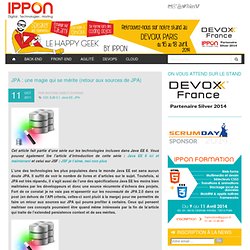

jOOQ is a fluent API for typesafe SQL query. Plain SQL. A DSL is a nice thing to have, it feels "fluent" and "natural", especially if it models a well-known language, such as SQL.

But a DSL is always expressed in a host language (Java in this case), which was not made for exactly the same purposes as its hosted DSL. If it were, then jOOQ would be implemented on a compiler-level, similar to LINQ in .NET. But it's not, and so, the DSL is limited by language constraints of its host language. We have seen many functionalities where the DSL becomes a bit verbose. This can be especially true for: You'll probably find other examples. jOOQ allows you to embed SQL as a String into any supported statement in these contexts: Plain SQL API methods are usually overloaded in three ways. Apart from the general factory methods, plain SQL is also available in various other contexts. Querydsl.
JSR317 JPA 2 Specification. Hibernate Persistence 4.0.1. Intended for new users, this chapter provides an step-by-step introduction to Hibernate, starting with a simple application using an in-memory database.

The tutorial is based on an earlier tutorial developed by Michael Gloegl. All code is contained in the tutorials/web directory of the project source. For this example, we will set up a small database application that can store events we want to attend and information about the host(s) of these events. The first thing we need to do is to set up the development environment. We will be using the "standard layout" advocated by alot of build tools such as Maven. We will be using Maven in this tutorial, taking advantage of its transitive dependency management capabilities as well as the ability of many IDEs to automatically set up a project for us based on the maven descriptor.
Chapter 6. Entity listeners and Callback methods. Hibernate EntityManager 4.0.1. The metamodel is a set of objects that describe your domain model. javax.persistence.metamodel.Metamodel acts as a repository of these metamodel objects and provides access to them, and can be obtained from either the javax.persistence.EntityManagerFactory or the javax.persistence.EntityManager via their getMetamodel method.

This metamodel is important in 2 ways. First, it allows providers and frameworks a generic way to deal with an application's domain model. Persistence providers will already have some form of metamodel that they use to describe the domain model being mapped. This API however defines a single, independent access to that existing information. A validation framework, for example, could use this information to understand associations; a marshaling framework might use this information to decide how much of an entity graph to marshal. Important. Infinispan Hibernate Issue. ObjectDB JPA. The Java Persistence API (JPA) provides various ways to retrieve objects from the database.

The retrieval of objects does not require an active transaction because it does not change the content of the database. The persistence context serves as a cache of retrieved entity objects. If a requested entity object is not found in the persistence context a new object is constructed and filled with data that is retrieved from the database (or from the L2 cache - if enabled). The new entity object is then added to the persistence context as a managed entity object and returned to the application. Notice that construction of a new managed object during retrieval uses the no-arg constructor. This page covers the following topics: Retrieval by Class and Primary Key Every entity object can be uniquely identified and retrieved by the combination of its class and its primary key. Retrieval by Eager Fetch.
JPA : une magie qui se mérite (retour aux sources de JPA) Cet article fait partie d’une série sur les technologies incluses dans Java EE 6.

Vous pouvez également lire l’article d’introduction de cette série : Java EE 6 ici et maintenant et celui sur JSF : JSF je t’aime, moi non plus L’une des technologies les plus populaires dans le monde Java EE est sans aucun doute JPA. Il suffit de voir le nombre de livres et d’articles sur le sujet. Toutefois, si JPA est très répandu, il s’agit aussi de l’une des spécifications Java EE les moins bien maîtrisées par les développeurs et donc une source récurrente d’échecs des projets. Fort de ce constat je ne vais pas m’apesentir sur les nouveauté de JPA 2.0 dans ce post (en dehors de l’API criteria, celles-ci sont pluôt à la marge) pour me permettre de faire un retour aux sources sur JPA qui pourra profiter à certains. Une “magie” complexe Les 4 piliers de JPA JPA s’inscrit autour de ces 4 notions fondamentales : Les transactions.